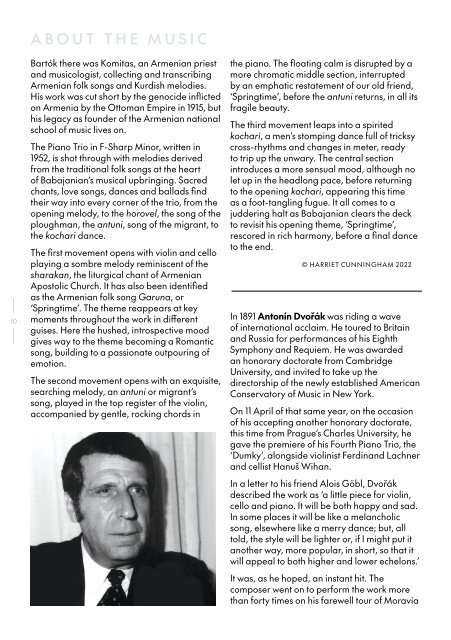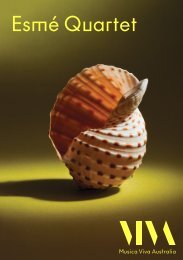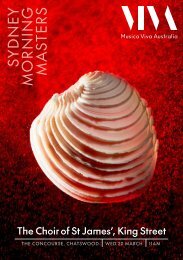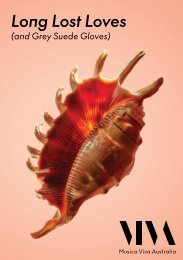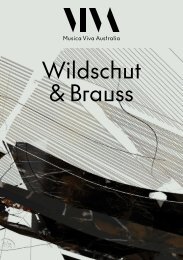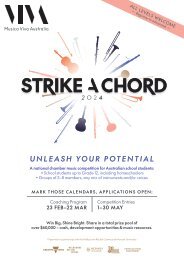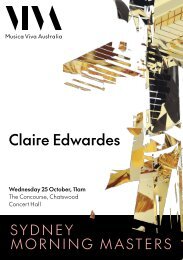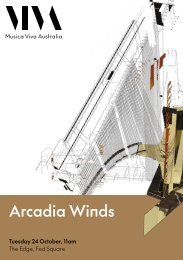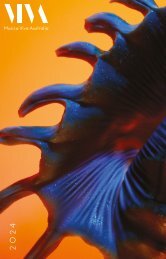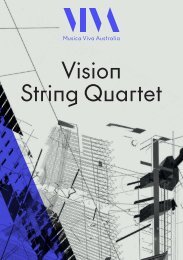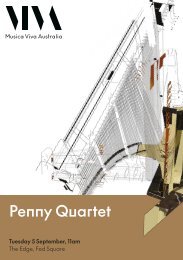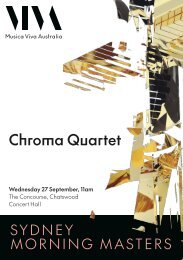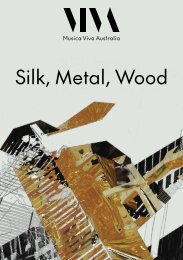Z.E.N. Trio Program Guide | August 2022
Create successful ePaper yourself
Turn your PDF publications into a flip-book with our unique Google optimized e-Paper software.
|<br />
10<br />
|<br />
ABOUT THE MUSIC<br />
Bartók there was Komitas, an Armenian priest<br />
and musicologist, collecting and transcribing<br />
Armenian folk songs and Kurdish melodies.<br />
His work was cut short by the genocide inflicted<br />
on Armenia by the Ottoman Empire in 1915, but<br />
his legacy as founder of the Armenian national<br />
school of music lives on.<br />
The Piano <strong>Trio</strong> in F-Sharp Minor, written in<br />
1952, is shot through with melodies derived<br />
from the traditional folk songs at the heart<br />
of Babajanian’s musical upbringing. Sacred<br />
chants, love songs, dances and ballads find<br />
their way into every corner of the trio, from the<br />
opening melody, to the horovel, the song of the<br />
ploughman, the antuni, song of the migrant, to<br />
the kochari dance.<br />
The first movement opens with violin and cello<br />
playing a sombre melody reminiscent of the<br />
sharakan, the liturgical chant of Armenian<br />
Apostolic Church. It has also been identified<br />
as the Armenian folk song Garuna, or<br />
‘Springtime’. The theme reappears at key<br />
moments throughout the work in different<br />
guises. Here the hushed, introspective mood<br />
gives way to the theme becoming a Romantic<br />
song, building to a passionate outpouring of<br />
emotion.<br />
The second movement opens with an exquisite,<br />
searching melody, an antuni or migrant’s<br />
song, played in the top register of the violin,<br />
accompanied by gentle, rocking chords in<br />
the piano. The floating calm is disrupted by a<br />
more chromatic middle section, interrupted<br />
by an emphatic restatement of our old friend,<br />
‘Springtime’, before the antuni returns, in all its<br />
fragile beauty.<br />
The third movement leaps into a spirited<br />
kochari, a men’s stomping dance full of tricksy<br />
cross-rhythms and changes in meter, ready<br />
to trip up the unwary. The central section<br />
introduces a more sensual mood, although no<br />
let up in the headlong pace, before returning<br />
to the opening kochari, appearing this time<br />
as a foot-tangling fugue. It all comes to a<br />
juddering halt as Babajanian clears the deck<br />
to revisit his opening theme, ‘Springtime’,<br />
rescored in rich harmony, before a final dance<br />
to the end.<br />
© HARRIET CUNNINGHAM <strong>2022</strong><br />
In 1891 Antonín Dvořák was riding a wave<br />
of international acclaim. He toured to Britain<br />
and Russia for performances of his Eighth<br />
Symphony and Requiem. He was awarded<br />
an honorary doctorate from Cambridge<br />
University, and invited to take up the<br />
directorship of the newly established American<br />
Conservatory of Music in New York.<br />
On 11 April of that same year, on the occasion<br />
of his accepting another honorary doctorate,<br />
this time from Prague’s Charles University, he<br />
gave the premiere of his Fourth Piano <strong>Trio</strong>, the<br />
‘Dumky’, alongside violinist Ferdinand Lachner<br />
and cellist Hanuš Wihan.<br />
In a letter to his friend Alois Göbl, Dvořák<br />
described the work as ‘a little piece for violin,<br />
cello and piano. It will be both happy and sad.<br />
In some places it will be like a melancholic<br />
song, elsewhere like a merry dance; but, all<br />
told, the style will be lighter or, if I might put it<br />
another way, more popular, in short, so that it<br />
will appeal to both higher and lower echelons.’<br />
It was, as he hoped, an instant hit. The<br />
composer went on to perform the work more<br />
than forty times on his farewell tour of Moravia


